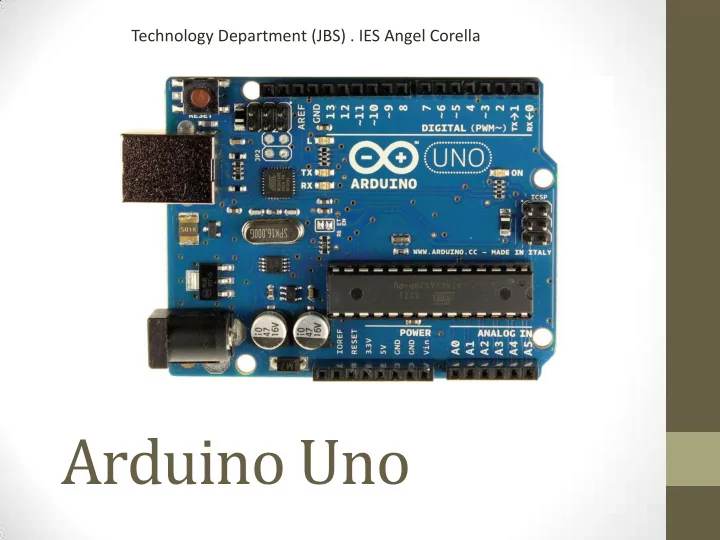

Technology Department (JBS) . IES Angel Corella Arduino Uno
INTRODUCTION 1. What is Microcontroller? 2. What is Arduino? 3. Types of Arduino 4. Arduino Uno Board 5. Arduino Shields 6. What is Arduino used for? 7. What can Arduino do? 8. Why Arduino? 9. Input/output 10. Analog/digital 11. Sensor
WHAT IS MICROCONTROLLER? • A small computer on a single chip containing a Central Processor Unit (CPU), flash memory, RAM and input/output interface. • Used for control purposes, and for data analysis
WHAT IS ARDUINO? • An open-source electronics platform based on easy-to-use hardware (electronic board) and software (IDE). www.arduino.cc • A electronic board, with on-board regulated power supply, USB port to communicate with PC, and an Atmel microcontroller chip. • Anyone can get the details of its design and modify it or make their own.
TYPES OF ARDUINO LilyPad Arduino Arduino Uno Arduino Nano
ARDUINO UNO BOARD
ARDUINO SHIELDS Boards plugged on top of the Arduino Printed Circuit Board (PCB) to extend its capacities.
WHAT IS ARDUINO USED FOR? • Physical Computing projects / research • Interactive Design • Rapid prototyping
WHAT CAN ARDUINO DO? • Sensors ( sense things) • Push buttons, touch pads, tilt switches. • Variable resistors (volume knob / sliders) • Photo-resistors (light intensity) • Thermistors (temperature) • Ultrasound (proximity range finder) • Actuators ( do things) • Lights, LED’s • Motors • Speakers • Displays (LCD)
WHY ARDUINO? • It is Open Source, both in terms of Hardware and Software. • It can communicate with a computer via serial connection over USB. • It can be powered from USB or standalone DC power. • It can run standalone from a computer (chip is programmable) and it has memory (a small amount). • It can work with both Digital and Analog electronic signals. Sensors and Actuators. • You can build robots, drone, home automation, IoT application, farm management system with Arduino.
INPUT/OUTPUT Input is a signal / information going into the board. Examples: Buttons Switches, Light Sensors, Flex Sensors, Humidity Sensors, Temperature Sensors, Photo-transistor, etc. Output is any signal exiting the board. Examples: LEDs, DC motor, Servo motor, Relay, Stepper motor, Piezo, Buzzer, RGB LED, etc.
ANALOG/DIGITAL Digital signal are anything that can take specific levels of values with specific offset between each other. Ex: Square waves Analog signal are anything that take value between its minimum value and maximum value. Ex: Temperature, Sine waves, etc.
SENSORS Devices that transforms the physical quantity in electrical value. The physical quantity could be • Light • Heat • Motion • Moisture • Pressure • Temperature • Blood pressure • Humidity • Speed • And others environmental phenomena
Recommend
More recommend